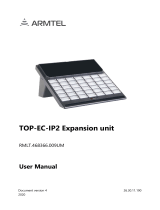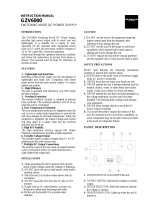
8
Cleaning ............................................................................................................................................................................. 37
Installing the Modules .......................................................................................................................................................... 38
Procedure............................................................................................................................................................................38
Channel Number ................................................................................................................................................................ 39
Location ................................................................................................................................................................................. 40
Bench Operation................................................................................................................................................................. 41
Rack Mounting...................................................................................................................................................................41
Input Connections................................................................................................................................................................. 42
Power Cord......................................................................................................................................................................... 42
Manually-Tightened Connectors ........................................................................................................................................ 42
8mm Screw Terminal Connector (option UJ1) ..................................................................................................................43
Wire Considerations ........................................................................................................................................................... 44
Control Connector ..............................................................................................................................................................46
Sense Switch ......................................................................................................................................................................47
Trigger and Digital Connections ........................................................................................................................................47
Computer Connections.........................................................................................................................................................48
GPIB Interface....................................................................................................................................................................48
RS-232 Interface ................................................................................................................................................................48
Application Connections ...................................................................................................................................................... 49
Local Sense Connections....................................................................................................................................................49
Remote Sense Connections ................................................................................................................................................ 49
Parallel Connections........................................................................................................................................................... 49
Low Voltage Operation......................................................................................................................................................51
TURN-ON CHECKOUT ......................................................................................................... 53
Introduction ..........................................................................................................................................................................53
Checkout Procedure .............................................................................................................................................................53
In Case of Trouble ................................................................................................................................................................ 54
Error Messages...................................................................................................................................................................54
Selftest Errors.....................................................................................................................................................................54
FRONT PANEL OPERATION ............................................................................................... 55
Introduction ..........................................................................................................................................................................55
Front Panel Description ....................................................................................................................................................... 55
System Keys...........................................................................................................................................................................57
Function keys ........................................................................................................................................................................ 58
Immediate Action Keys......................................................................................................................................................58
Scrolling Keys....................................................................................................................................................................59
Metering Keys....................................................................................................................................................................59
Input Control Keys............................................................................................................................................................. 60
Transient Control Keys ......................................................................................................................................................61
Trigger Control Keys.......................................................................................................................................................... 61
List Control Keys ............................................................................................................................................................... 61
Entry Keys............................................................................................................................................................................. 62
Examples of Front Panel Programming ............................................................................................................................. 63
1 - Using the Front Panel Display ......................................................................................................................................63
2 - Programming Constant Current, Voltage and Resistance Modes .................................................................................63
3 - Programming Transient Operation................................................................................................................................ 65
4 - Programming Lists........................................................................................................................................................67
5 - Querying and Clearing Output Protection and Errors ................................................................................................... 68
6 - Making Basic Front Panel Measurements..................................................................................................................... 69
7 - Setting the GPIB Address ............................................................................................................................................. 70
8 - Storing and Recalling Instrument States ....................................................................................................................... 70
SPECIFICATIONS................................................................................................................. 71





















